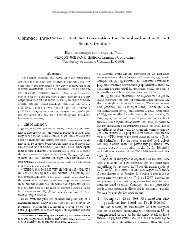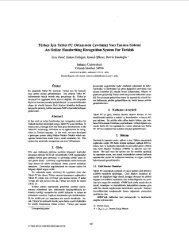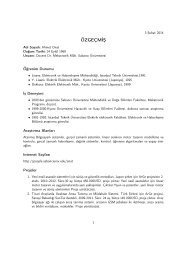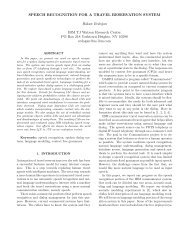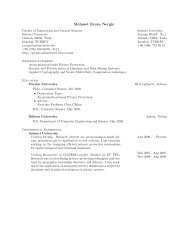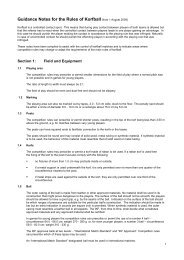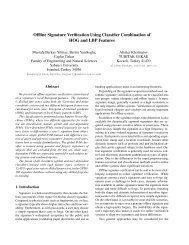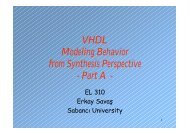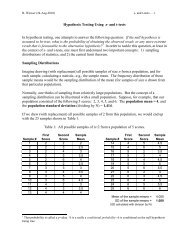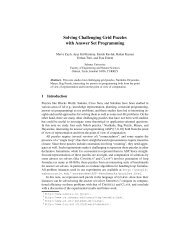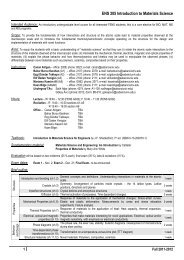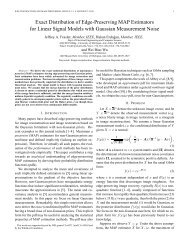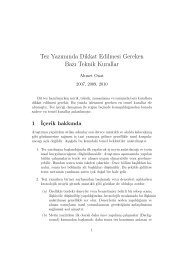Answer Set Programming
Answer Set Programming
Answer Set Programming
Create successful ePaper yourself
Turn your PDF publications into a flip-book with our unique Google optimized e-Paper software.
CS 504, Fall 2008<br />
Knowledge Representation and Reasoning<br />
<strong>Answer</strong> <strong>Set</strong> <strong>Programming</strong> ∗<br />
<strong>Answer</strong> set programming (ASP) is a form of declarative programming oriented<br />
towards difficult combinatorial search problems. It has been applied, for instance, to<br />
plan generation and product configuration problems in artificial intelligence and to<br />
graph-theoretic problems arising in VLSI design and in historical linguistics.<br />
Syntactically, ASP programs look like Prolog programs, but the computational<br />
mechanisms used in ASP are different: they are based on the ideas that have led to the<br />
development of fast satisfiability solvers for propositional logic.<br />
<strong>Answer</strong> set programming has emerged from interaction between two lines of research<br />
— on the semantics of negation in logic programming [Gelfond and Lifschitz,<br />
1988] and on applications of satisfiability solvers to search problems [Kautz and Selman,<br />
1992]. It was identified as a new programming paradigm in [Lifschitz, 1999;<br />
Marek and Truszczyński, 1999; Niemelä, 1999].<br />
Computing <strong>Answer</strong> <strong>Set</strong>s with LPARSE and SMODELS<br />
In this section we discuss the use of the answer set solver created by Ilkka Niemelä’s<br />
group at the Helsinki University of Technology. The system consists of two programs,<br />
LPARSE and SMODELS; the former is a preprocessor. It can be downloaded from its<br />
web site, http://www.tcs.hut.fi/Software/smodels/.<br />
The syntax of the input language of LPARSE is more limited in some ways than the<br />
class of programs defined in the previous lecture notes (“<strong>Answer</strong> <strong>Set</strong>s”), but it includes<br />
many useful special cases. In the input language of LPARSE, the head of a rule can be<br />
• an atom,<br />
• empty (that is, ⊥),<br />
• an expression of one of the forms<br />
{F 1 , . . . , F n } c<br />
l ≤ {F 1 , . . . , F n } c<br />
{F 1 , . . . , F n } c ≤ u<br />
l ≤ {F 1 , . . . , F n } c ≤ u<br />
provided that the formulas F i are atoms.<br />
∗ Some parts of this note are taken from the survey “Introduction to <strong>Answer</strong> <strong>Set</strong> <strong>Programming</strong>” by<br />
Vladimir Lifschitz.<br />
1
CS 504, Fall 2008<br />
Knowledge Representation and Reasoning<br />
In the last case, the superscript c and the sign ≤ are dropped. For instance,<br />
in the head of a rule stands for<br />
The body can be a conjunction (possibly empty) of<br />
• atoms possibly preceded with not,<br />
• expressions of the forms<br />
1{p, q} (1)<br />
1 ≤ {p, q} c . (2)<br />
l ≤ {F 1 , . . . , F n }<br />
{F 1 , . . . , F n } ≤ u<br />
l ≤ {F 1 , . . . , F n } ≤ u<br />
provided that each F i is an atom possibly preceded with not.<br />
In the last case, the sign ≤ is dropped. For instance, expression (1), when it occurs in<br />
a body of an LPARSE rule, stands for<br />
1 ≤ {p, q}.<br />
Note that this expression is different from (2).<br />
In the input language of LPARSE, :- stands for ←, and each rule is followed by a<br />
period.<br />
If we want to find, for instance, the answer sets for the program<br />
we create the file<br />
p :- not q.<br />
q :- not p.<br />
r :- p.<br />
r :- q.<br />
p ← not q<br />
q ← not p<br />
r ← p<br />
r ← q<br />
called, say, input.lp . Then we invoke LPARSE and SMODELS as follows:<br />
% lparse input.lp | smodels 0<br />
The zero at the end indicates that we want to compute all answer sets; a positive number<br />
k would tell SMODELS to terminate after computing k answer sets. The default<br />
value of k is 1. The main part of the output generated in response to this command<br />
line is the list of the program’s answer sets:<br />
2
CS 504, Fall 2008<br />
Knowledge Representation and Reasoning<br />
<strong>Answer</strong>: 1<br />
Stable Model: r p<br />
<strong>Answer</strong>: 2<br />
Stable Model: r q<br />
(“stable model” means “answer set”).<br />
Problem 1 Use SMODELS to find the answer sets for the program<br />
{p, q} c<br />
← p, q.<br />
A group of rules that follow a pattern can be often described in a compact way<br />
using variables. Variables must be capitalized. Consider, for instance, the programs Π n<br />
p i ← not p i+1<br />
(1 ≤ i ≤ n).<br />
To describe Π 7 , we don’t have to write out each of its 7 rules. Let’s agree to use the<br />
symbol index to represent a number between 1 and 7. We can write Π 7 as<br />
index(1..7).<br />
p(I) :- not p(I+1), index(I).<br />
The auxiliary symbols used in the input language of LPARSE to describe the ranges of<br />
variables, such as index, are called domain predicates. The “definitions” of domain<br />
predicates, such as index(1..7), tell LPARSE how to substitute specific values for<br />
variables in schematic expressions, such as p(I) :- not p(I+1). Grounding—<br />
translating schematic expressions into sets of rules—is the main computational task<br />
performed by LPARSE.<br />
When the input file uses domain predicates, the output of SMODELS lists the objects<br />
satisfying each domain predicate along with the elements of the answer set:<br />
<strong>Answer</strong>: 1<br />
Stable Model: p(1) p(3) p(5) p(7) index(1) index(2)<br />
index(3) index(4) index(5) index(6) index(7)<br />
Information on the extents of domain predicates in the output can be suppressed by<br />
including a hide directive in the input file:<br />
hide index(_).<br />
The family of programs Π n can be described by a schema with the parameter n:<br />
index(1..n).<br />
p(I) :- not p(I+1), index(I).<br />
When this schematic description is given to LPARSE as input, the value of the constant<br />
n should be specified in the command line using the option -c, as follows:<br />
3
CS 504, Fall 2008<br />
Knowledge Representation and Reasoning<br />
% lparse -c n=7 p.lp | smodels 0<br />
Problem 2 Consider the program obtained from Π n by adding the rule<br />
p n+1 ← not p 1 .<br />
How many answer sets does this program have, in your opinion? Check your conjecture<br />
for n = 7 and n = 8 using SMODELS.<br />
Variables can be also used “locally” to describe the list of formulas in a cardinality<br />
expression. The domain predicate characterizing the range of a local variable is placed<br />
inside the braces. For instance, the rule<br />
1 ≤ {p 1 , . . . , p n } ≤ 1<br />
can be represented in an LPARSE input file by the lines<br />
index(1..n).<br />
1{p(I) : index(I)}1.<br />
Problem 3 Consider the program<br />
1 ≤ {p i1 , . . . , p in } c ≤ 1 (1 ≤ i ≤ n),<br />
where n is a positive integer. How many answer sets does this program have, in your<br />
opinion? Check your conjecture for n = 3 using SMODELS.<br />
A detailed description of the input language of LPARSE, as well as the complete list<br />
of options of LPARSE and SMODELS, can be found in the system’s manual, available<br />
at its web site.<br />
Besides SMODELS, there are some other answer set solvers that use LPARSE for<br />
grounding, such as ASSAT 1 , CMODELS 2 , and CLASP 3 . Among other existing systems<br />
for computing answer sets, DLV 4 stands out by virtue of two things: it uses a very<br />
efficient grounding mechanism, and it can process rules containing disjunctions of<br />
several atoms in the head.<br />
Methodology of ASP<br />
To solve a problem using ASP means to write a program whose answer sets correspond<br />
to solutions, and then find a solution using an answer set solver, such as SMODELS. The<br />
basic approach to writing such a program is known as the “generate-and-test” strategy.<br />
First we write a group of rules whose heads contain choice expressions so that the<br />
1 http://assat.cs.ust.hk/ .<br />
2 http://www.cs.utexas.edu/users/tag/cmodels/ .<br />
3 http://www.cs.uni-potsdam.de/clasp/.<br />
4 http://www.dbai.tuwien.ac.at/proj/dlv/ .<br />
4
CS 504, Fall 2008<br />
Knowledge Representation and Reasoning<br />
answer sets for this group of rules correspond to “potential solutions”—an easy-todescribe<br />
superset of the set of solutions. Then we add a group of constraints that weed<br />
out the potential solutions that are not solutions.<br />
Consider, for instance, the use of this method to solve the n-queens problem. The<br />
goal is to place n queens on an n × n chessboard so that no two queens would be<br />
placed on the same row, column or diagonal. A solution can be described by a set of<br />
atoms of the form q(i, j) (1 ≤ i, j ≤ n); including q(i, j) in the set indicates that there<br />
is a queen at position (i, j). A solution is a set X satisfying the following conditions:<br />
1. The cardinality of X is n.<br />
2. X does not contain a pair of different atoms of the form q(i, j), q(i ′ , j) (two<br />
queens in the same row).<br />
3. X does not contain a pair of different atoms of the form q(i, j), q(i, j ′ ) (two<br />
queens in the same column).<br />
4. X does not contain a pair of different atoms q(i, j), q(i ′ , j ′ ) with |i ′ − i| = |j ′ − j|<br />
(two queens on the same diagonal).<br />
The sets satisfying Conditions 1 and 2 can be described by the rules<br />
1 ≤ {q(1, j), . . . , q(n, j)} c ≤ 1 (1 ≤ j ≤ n)<br />
(exactly one queen in each row). These rules form the “generate” part of our program.<br />
The “test” part consists of the constraints expressing Condition 3<br />
and Condition 4<br />
← q(i, j), q(i, j ′ ) (1 ≤ i, j, j ′ ≤ n; j < j ′ )<br />
← q(i, j), q(i ′ , j ′ )<br />
(1 ≤ i, i ′ j, j ′ ≤ n; j < j ′ ; |i ′ − i| = j ′ − j).<br />
Here is a representation of this program in the input language of LPARSE:<br />
number(1..n).<br />
1{q(I,J) : number(I)}1 :- number(J).<br />
:- q(I,J), q(I,J1),<br />
number(I;J;J1), J
CS 504, Fall 2008<br />
Knowledge Representation and Reasoning<br />
The expression number(I;J;J1) is the LPARSE abbreviation for<br />
number(I), number(J), number(J1).<br />
Note the conditions J
CS 504, Fall 2008<br />
Knowledge Representation and Reasoning<br />
for all edges {u, v} of G. Using these atoms, we express Condition 2 by the constraints<br />
← not r(u) (7)<br />
for all u ∈ V .<br />
<strong>Answer</strong> sets for program (3)–(7) are in a 1–1 correspondence with the Hamiltonian<br />
circuits in G. Rules (4) and (6) form the define part of the program, and rules (5)<br />
and (7) form the test part.<br />
The following file hc is an LPARSE encoding of program (3)–(7), in which we<br />
assume that the vertices of G are integers, and v 0 = 0:<br />
{in(U,V)} :- edge(U,V).<br />
adj(U,V) :- in(U,V), vertex(U;V).<br />
adj(V,U) :- in(U,V), vertex(U;V).<br />
:- {adj(U,V) : vertex(V)}1, vertex(U).<br />
:- 3{adj(U,V) : vertex(V)}, vertex(U).<br />
r(0).<br />
r(U) :- r(V), adj(U,V), vertex(U;V).<br />
:- not r(U), vertex(U).<br />
hide.<br />
show in(_,_).<br />
(The last two lines tell SMODELS to display the in atoms only.)<br />
This file needs to be appended to a description of G in the form of a definition of<br />
the domain predicates vertex and edge. For instance, the file<br />
vertex(0..7).<br />
edge(U,U+1) :- vertex(U), U!=3, U!=7.<br />
edge(0,3).<br />
edge(4,7).<br />
edge(U,U+4) :- vertex(U), U
CS 504, Fall 2008<br />
Knowledge Representation and Reasoning<br />
In each of the following exercises, show how to solve the given computational<br />
problem using SMODELS. For the first three exercises below, as in the Hamiltonian<br />
circuit example, use specific data (of your choice) to test your program.<br />
Problem 6 A clique in a graph G is a subset of its vertices whose elements are pairwise<br />
adjacent. 5 Determine whether G has a clique of cardinality n.<br />
Problem 7 You are organizing a large New Year’s Eve party. There will be n tables in<br />
the room, with m chairs around each table. You need to select a table for each of the<br />
guests, who are assigned numbers from 1 to mn, so that two conditions are satisfied.<br />
First, some guests like each other and want to sit together; accordingly, you are given<br />
a set A of two-element subsets of {1, . . . , mn}, and, for every {i, j} in A, guests<br />
i and j should be assigned the same table. Second, some guests dislike each other<br />
and want to sit at different tables; accordingly, you are given a set B of two-element<br />
subsets of {1, . . . , mn}, and, for every {i, j} in B, guests i and j should be assigned<br />
different tables. The goal is to find such a seating arrangement or determine that this<br />
is impossible.<br />
Problem 8 You are in charge of assigning referees to the papers submitted to a conference.<br />
Each of the n submissions needs to be assigned to a few referees from among<br />
the m members of the Program Committee. The PC members have read the abstracts<br />
of all submissions, and each of them gave you the numbers of the submissions that he<br />
is qualified to referee; let A i (1 ≤ i ≤ m) be the subset of {1, . . . , n} given to you by<br />
the i-th committee member. You need to select, for each i, a set X i of papers to be assigned<br />
to the i-th committee member so that three conditions are satisfied. First, each<br />
X i should be a subset of A i . Second, the cardinality of each X i should be between a<br />
lower bound l and an upper bound u. Third, each paper should be assigned to exactly<br />
k referees. The goal is to find such an assignment of papers to referees or determine<br />
that this is impossible.<br />
Problem 9 Each of four men owns a different species of exotic pet. From the following<br />
clues, can you figure out each man’s full name and what kind of pet he owns?<br />
1. Mr. Engel (whose pet is named Sparky), Abner and Mr. Foster all belong to a<br />
club for owners of unusual pets.<br />
2. The iguana is not owned by either Chuck or Duane.<br />
3. Neither the jackal nor the king cobra is owned by Mr. Foster.<br />
4. The Ilama does not belong to Duane (whose pet is named Waggles).<br />
5. Abner, who does not own the king cobra, is not Mr. Gunter.<br />
6. Bruce and Mr. Foster are neighbors.<br />
5 http://mathworld.wolfram.com/Clique.html .<br />
8
CS 504, Fall 2008<br />
Knowledge Representation and Reasoning<br />
7. Mr. Halevy is afraid of iguanas.<br />
Problem 10 A set A of integers is called sum-free if there are no numbers x, y in A<br />
such that x + y is in A also (x and y do not need to be different). The Schur number<br />
S(k) is the largest integer n for which the interval {1, . . . , n} can be partitioned into<br />
k sum-free sets. 6 Write a program that computes S(k), and try it for k = 1, 2, 3.<br />
References<br />
[Gelfond and Lifschitz, 1988] Michael Gelfond and Vladimir Lifschitz. The stable<br />
model semantics for logic programming. In Robert Kowalski and Kenneth Bowen,<br />
editors, Proceedings of International Logic <strong>Programming</strong> Conference and Symposium,<br />
pages 1070–1080, 1988.<br />
[Kautz and Selman, 1992] Henry Kautz and Bart Selman. Planning as satisfiability.<br />
In Proceedings of European Conference on Artificial Intelligence (ECAI), pages<br />
359–363, 1992.<br />
[Lifschitz, 1999] Vladimir Lifschitz. Action languages, answer sets and planning.<br />
In The Logic <strong>Programming</strong> Paradigm: a 25-Year Perspective, pages 357–373.<br />
Springer Verlag, 1999.<br />
[Marek and Truszczyński, 1999] Victor Marek and Mirosław Truszczyński. Stable<br />
models and an alternative logic programming paradigm. In The Logic <strong>Programming</strong><br />
Paradigm: a 25-Year Perspective, pages 375–398. Springer Verlag, 1999.<br />
[Niemelä, 1999] Ilkka Niemelä. Logic programs with stable model semantics as a<br />
constraint programming paradigm. Annals of Mathematics and Artificial Intelligence,<br />
25:241–273, 1999.<br />
6 See http://mathworld.wolfram.com/SchurNumber.html .<br />
9



